All About the Okapi: The Forest Giraffe
The Okapi, often referred to as the “forest giraffe,” is a unique and elusive animal found in the dense rainforests of the Democratic Republic of Congo. Though it shares some similarities with giraffes, such as its long legs and ossicones (the bony structures on its head), the Okapi has its own distinct features that set it apart. With its zebra-like striped legs and an elegant, long neck, it’s easy to see why this animal has fascinated scientists and wildlife enthusiasts alike.
Often called the “African unicorn” due to its rarity and mysterious nature, the Okapi is a living testament to the wonders of the natural world. Despite being closely related to the giraffe, the Okapi’s appearance and behavior make it a species unlike any other. This guide will explore the Okapi’s fascinating traits, its classification, habitat, diet, and conservation status to give you an in-depth understanding of this remarkable animal.
What is an Okapi?
The Okapi (Okapia johnstoni) is an herbivorous mammal native to the dense forests of Central Africa. Although it shares a distant ancestry with the giraffe, its appearance resembles a combination of a giraffe and a zebra. Unlike giraffes, which are found in open savannahs, Okapis are solitary, elusive creatures that thrive in the thick, lowland forests of the Democratic Republic of Congo (DRC). They are particularly hard to spot due to their excellent camouflage, which helps protect them from predators.
The Okapi was only discovered by Western scientists in the early 20th century, though it has long been known to local tribes in Africa. Its first formal description was published in 1901, and since then, it has captured the curiosity of biologists, conservationists, and wildlife lovers around the world.
Okapi Characteristics and Classification
Here’s a detailed table breaking down the key characteristics and classification of the Okapi:
| Feature | Description |
|---|---|
| Scientific Name | Okapia johnstoni |
| Common Name | Okapi, Forest Giraffe, African Unicorn |
| Family | Giraffidae (Giraffe family) |
| Relatives | Giraffe, other Giraffidae members |
| Habitat | Dense rainforests of the Democratic Republic of Congo |
| Diet | Herbivore (leaves, fruits, fungi) |
| Lifespan | 20-30 years in the wild |
| Physical Traits | Zebra-like striped legs, giraffe-like long neck, prehensile tongue, ossicones (horn-like structures) |
| Size | 1.5–2.0 meters tall, 2.5–3.0 meters long |
| Weight | 200-300 kg (440-660 lbs) |
| Color | Dark brown to reddish with white stripes on the legs |
| Behavior | Solitary, nocturnal, elusive |
| Predators | Leopards, humans (poaching) |
| Conservation Status | Endangered (IUCN Red List) |
Key Features and Classification Explained
Scientific Classification:
The Okapi belongs to the Giraffidae family, making it a distant relative of the giraffe. Despite its similarities to the giraffe, it is classified in a different genus—Okapia. This makes it the only extant member of the genus Okapia.
Physical Traits:
The Okapi has a sleek, dark brown coat with striking white stripes on its legs, resembling a zebra. These stripes help the Okapi blend in with the dappled sunlight of its forest environment, making it a master of camouflage.
Like its giraffe relatives, the Okapi has ossicones—two horn-like structures on its head. However, unlike the giraffe, the Okapi’s ossicones are smaller and more rounded.
Its long neck and large ears are key features that help it navigate the dense forest and detect any approaching predators or other threats.
Habitat and Distribution:
Okapis are native to the rainforests of the DRC, particularly in the Ituri Forest. They thrive in dense, lowland forests where they can find abundant food and shelter. Unlike giraffes, which roam open grasslands, Okapis are more solitary and prefer the dense underbrush of the forest floor.
Diet and Feeding Habits:
Okapis are herbivores that feed primarily on leaves, fruits, and fungi. Their long prehensile tongue allows them to grasp branches and strip leaves from trees, much like a giraffe. They are known to be selective feeders, choosing the most nutritious plants.
Behavior:
Okapis are solitary creatures that are mostly nocturnal, coming out at night to forage for food. They communicate with each other through scent marking and vocalizations, though their shy nature means they are difficult to observe in the wild.
Why Is the Okapi Called the "Forest Giraffe"?
The Okapi earned the nickname “forest giraffe” due to its physical resemblance to giraffes. While giraffes are tall and majestic creatures that roam the open savannah, Okapis are much smaller and are adapted to a more secluded, forest-dwelling lifestyle. Despite their differences, the Okapi and the giraffe share a common ancestor, which is why they share similar physical features like their long necks and ossicones.
The term “forest giraffe” highlights the Okapi’s position as a rare and unique creature in the animal kingdom, blending the traits of two familiar animals—giraffes and zebras—into one fascinating species.
Okapi Habitat and Range
The Okapi (Okapia johnstoni) is an enigmatic creature native to the dense rainforests of the Democratic Republic of Congo (DRC), located in Central Africa. This solitary animal thrives in the lowland tropical forests of the DRC’s Ituri Forest, a region known for its thick vegetation and rich biodiversity. These rainforests are vital to the Okapi’s survival, providing both shelter and food.
The Forest Environment of the Okapi
The Okapi is perfectly adapted to the dense, shadowy undergrowth of the forest. Its coat, a combination of dark brown and reddish hues with striking white stripes on its legs, allows it to blend seamlessly with the dappled sunlight filtering through the dense foliage. This camouflage helps it evade predators such as leopards and human poachers. Despite being closely related to the giraffe, the Okapi prefers a much different environment—dense forests, as opposed to the open grasslands giraffes are typically found in.
The Okapi’s habitat is primarily situated in the rainforests of the DRC, covering a large portion of the Ituri Forest. This region provides a perfect home for the Okapi, offering an abundance of leaves, fruits, and other vegetation to feed on, while also offering protection from predators. However, this delicate ecosystem is under threat from deforestation, logging, and human activities. These environmental challenges have contributed to a decline in the Okapi’s population, making them more vulnerable to extinction.
Challenges to Okapi’s Habitat
Deforestation, due to illegal logging and agricultural expansion, is one of the biggest threats to the Okapi’s habitat. As the forests shrink, the Okapis’ territory is rapidly diminished, which limits their ability to find sufficient food and shelter. Furthermore, human activities near the Okapi’s habitat increase the risk of poaching and other harmful interventions that put further stress on the already endangered species.
Okapis rely on the dense vegetation for both food and camouflage. The forest’s canopy provides them with ample foliage, while the dark, rich soils of the forest floor offer ideal conditions for their diet of leaves, fruits, and fungi. Yet, without effective conservation measures, the Okapi’s habitat continues to face degradation.
Where Do Okapis Live in the Wild?
Okapis live in the wild exclusively in the rainforests of the DRC. They are not found anywhere else in the world. The combination of their elusive nature and the difficulty of accessing their habitat means that spotting an Okapi in the wild is an extraordinary occurrence. The region’s dense forests act as a natural barrier, protecting them from easy observation by humans and most predators. However, as climate change and human activities continue to threaten their environment, the survival of the Okapi in the wild remains uncertain.
What Do Okapis Eat?
The Okapi is a herbivore, feeding on a variety of plant material found in its forest home. Its diet consists primarily of leaves, fruits, fungi, and other vegetation. Due to its long neck and specialized tongue, the Okapi is adept at foraging for high-up foliage, allowing it to feed on leaves from trees and shrubs that are out of reach for many other forest creatures. Its tongue, which can extend up to 18 inches, is especially useful for grabbing and stripping leaves from branches, much like its distant giraffe relatives.
Okapi Diet and Feeding Behavior
Okapis are selective feeders, preferring to eat high-nutrient, tender leaves from trees like the wild ginger plant, as well as fruits and fungi that grow on the forest floor. This herbivorous diet helps maintain the Okapi’s health and energy levels, especially in the dense forest environment where food sources are plentiful but often spread out.
Interestingly, Okapis also play an essential role in their ecosystem through seed dispersal. As they consume fruits and leaves, they help to spread seeds across the forest floor, contributing to the overall health and regeneration of the forest ecosystem. Their feeding habits not only sustain their own population but also contribute to maintaining the balance of the forest’s biodiversity.
Okapi’s Adaptation to Its Diet
The Okapi’s long, prehensile tongue allows it to strip leaves from tall trees, providing it access to food that would otherwise be out of reach. Additionally, their large, muscular lips help them grasp and manipulate food, allowing for efficient consumption of leaves and fruit. While the Okapi is not a “grazing” animal like the giraffe, its unique feeding habits help it thrive in the dense forests of the DRC.
Okapi Behavior and Communication
The Okapi is primarily a solitary and nocturnal creature. It spends much of its time hidden in the dense forests of the DRC, using its keen senses to avoid predators. The Okapi is known for its shy, elusive nature, making it difficult to observe in the wild. Despite being a member of the Giraffidae family, the Okapi’s behavior contrasts significantly with its larger, more social relatives, the giraffes.
Solitary and Nocturnal Nature
Okapis are solitary animals that prefer to live alone except during mating season. They are highly territorial, using scent marking to communicate with other Okapis. Their solitary lifestyle is adapted to their dense forest environment, where space and resources are more limited. This behavior helps reduce competition for food and ensures their survival in the wild.
Since Okapis are nocturnal, they are most active at night. During the day, they typically remain hidden in the forest, coming out at dusk to forage for food. Their nocturnal habits help them avoid predators such as leopards, which are more active during the day.
Communication and Scent Marking
One of the most fascinating aspects of Okapi behavior is their communication methods. Okapis communicate with each other using a variety of vocalizations, though they are relatively quiet compared to many other animals. They also rely heavily on scent marking to communicate their presence and territory. By marking trees and vegetation with their scent glands, Okapis signal their location and define their boundaries within the forest.
What Noise Does an Okapi Make?
Okapis are not known for making loud vocalizations like many other mammals. Instead, they produce soft, low-frequency sounds that are difficult for humans to detect. These infrasonic sounds allow Okapis to communicate over long distances without alerting predators. These subtle sounds are often described as soft “grunts” or low-pitched calls, used primarily for communication within the dense forest.
Sensitivity to Predators
Okapis are highly sensitive to changes in their environment. They have excellent hearing and vision, which they use to detect any potential threats, including leopards or humans. Their large, mobile ears allow them to pick up even the slightest sound, while their large eyes help them detect movement in the thick undergrowth.
Okapi Conservation Status: How Many Okapis Are Left in the World?
The Okapi is currently listed as Endangered on the IUCN Red List, with an estimated population of fewer than 50,000 individuals remaining in the wild. The primary threats to the Okapi’s survival include habitat loss, poaching, and human conflict in the DRC. These factors have led to a significant decline in the Okapi population over the past few decades.
Threats to the Okapi’s Survival
One of the biggest challenges faced by Okapis is habitat destruction. The forests where they live are being cleared for agriculture, logging, and human settlements. This not only reduces their living space but also disrupts the delicate ecosystems that sustain them. As their habitat shrinks, Okapis are forced to move into areas where food and shelter are scarce, further threatening their survival.
In addition to habitat loss, poaching is another major threat. Okapis are often hunted for their meat, skins, and bones, which are valuable on the black market. Despite the creation of protected areas like the Okapi Wildlife Reserve, poaching remains a significant challenge due to the ongoing instability in the region.
Conservation Efforts
There are several conservation programs dedicated to protecting Okapis and their habitat. The Okapi Wildlife Reserve, established in 1992 in the DRC, is one of the most significant conservation efforts. This reserve is a UNESCO World Heritage site and provides a safe haven for Okapis, along with other endangered species.
International organizations, such as the World Wildlife Fund (WWF) and the Congolese Institute for Nature Conservation (ICCN), have been working tirelessly to protect Okapi populations. These organizations focus on combating poaching, supporting local communities, and promoting sustainable land-use practices.
What Can We Do to Help?
To support Okapi conservation, individuals can donate to wildlife protection organizations or participate in eco-tourism initiatives that benefit the local communities and help preserve the Okapi’s habitat. Raising awareness about the
Okapi’s endangered status is also crucial for rallying support and ensuring a future for this incredible species.
By supporting these efforts and spreading knowledge about the Okapi, we can help ensure that future generations will continue to witness the magic of the “forest giraffe.”
Fun Facts About the Okapi
The Okapi is full of fascinating and quirky details that make it one of the most unique animals on the planet. Often called the “African unicorn,” the Okapi has earned this nickname because of its elusive nature and the mystery surrounding its discovery.
1. The Okapi Was a Mystery to the Outside World
Although the Okapi has been known to the indigenous people of the DRC for centuries, it remained a mystery to the Western world until the early 20th century. In fact, the Okapi was only officially discovered by the outside world in 1901, making it one of the last major mammal species to be identified by science. Its discovery was so remarkable that it was initially thought to be a mythical creature, leading to its “unicorn” status.
2. Half Giraffe, Half Zebra
One of the most striking features of the Okapi is its appearance, which seems like a cross between a giraffe and a zebra. Its long neck and ossicones (the horn-like structures on its head) clearly show its relation to giraffes, while its zebra-like striped legs give it a distinctive look that sets it apart from its cousins in the giraffe family.
3. A Long, Prehensile Tongue
Another interesting trait of the Okapi is its incredibly long tongue, which can reach lengths of up to 18 inches! This prehensile tongue helps the Okapi strip leaves from branches high in the trees and even clean its own eyes and ears. It’s an excellent adaptation for foraging in the dense, forested environments where Okapis live.
4. Shy and Elusive
Okapis are notoriously shy and reclusive animals. Their elusive nature makes them difficult to study in the wild, as they tend to avoid human interaction and remain hidden in the dense underbrush of the rainforest. This has contributed to the air of mystery that surrounds them.
The Okapi's Relatives: Giraffes and Other Animals
Okapis and giraffes are closely related, sharing a common ancestor in the Giraffidae family. While giraffes are known for their towering necks and spotted coats, Okapis are much smaller, with zebra-like stripes on their legs and a more solitary nature.
Giraffe Family Connections
Both the Okapi and giraffe belong to the same family, Giraffidae, and share a distant evolutionary lineage. They are the only two extant species in this family, which was once more diverse. The Okapi’s long neck and ossicones (horn-like structures on the head) are a testament to this connection, even though it doesn’t have the giraffe’s extreme height.
Other Relatives
In addition to the giraffe, the Okapi’s closest relatives include the Muntjac, a species of small deer, and the Giraffokeryx, a prehistoric ancestor of the giraffe. The Okapi and giraffe’s common traits, such as their long necks and distinct skin patterns, can be traced back to these shared ancestors.
Despite their similarities, Okapis and giraffes have adapted to their environments in very different ways. While giraffes roam the savannah, Okapis thrive in dense rainforests, where they rely on their camouflage and solitary behavior for survival.
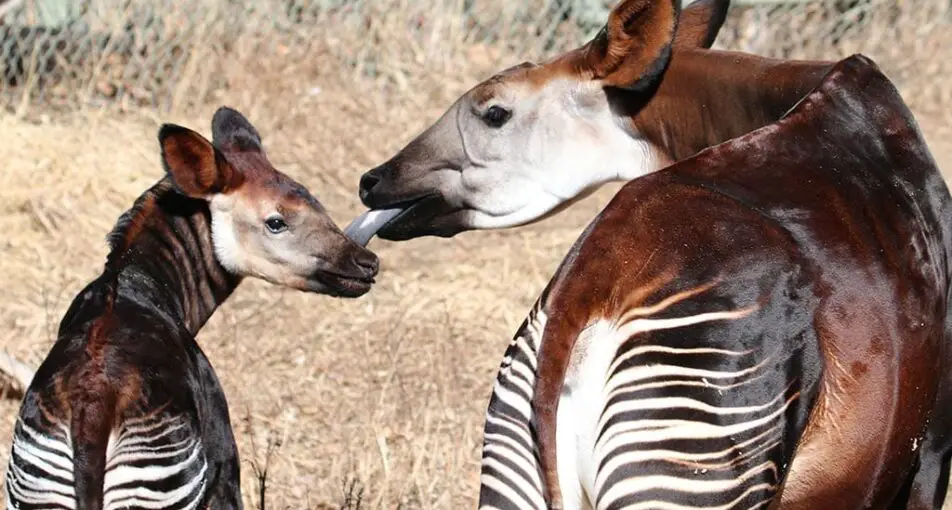
Okapi in Popular Culture and Symbolism
The Okapi, with its elusive nature and striking appearance, has made its mark in popular culture and folklore, often symbolizing mystery and wonder.
The Okapi as the “African Unicorn”
In African culture, the Okapi is sometimes referred to as a “forest unicorn” because of its rare and almost mythical status. This label reflects the Okapi’s elusive nature and the fact that it remained largely unknown to the Western world for centuries, adding to its mystique. The Okapi is often used as a symbol of the hidden wonders of the Congo’s rainforests.
In Popular Culture
The Okapi has appeared in various forms of popular media, including documentaries and wildlife films. It has also inspired the imagination of writers and artists, symbolizing the uniqueness of Africa’s wildlife and the importance of preserving it.
In African folklore, the Okapi is sometimes associated with the spiritual world, representing strength and mystery. Its image as the “African unicorn” has captured the attention of wildlife enthusiasts and conservationists worldwide.
How You Can Help Okapi Conservation
The Okapi is currently classified as Endangered, and with fewer than 50,000 Okapis remaining in the wild, it is crucial to support efforts that help protect this incredible species and its rainforest habitat. You can help by getting involved in Okapi conservation in the following ways:
Donate to Conservation Organizations
Several organizations, such as the World Wildlife Fund (WWF) and the Congolese Institute for Nature Conservation (ICCN), work tirelessly to protect Okapi populations in the wild. Donations to these groups help fund research, anti-poaching efforts, and habitat restoration projects.
Support Eco-Tourism and Sustainable Practices
Eco-tourism plays a critical role in supporting local communities and preserving the Okapi’s habitat. By participating in responsible wildlife tours in the DRC, you can help fund conservation projects and raise awareness about the Okapi’s endangered status. Sustainable land-use practices are also essential to ensuring the future of the Okapi in the wild.
Spread Awareness
Raising awareness about the Okapi’s plight is an important step in protecting the species. Share information about the Okapi’s conservation status and the importance of preserving rainforests with your friends, family, and community. The more people know about the Okapi, the more support it will receive.
FAQs- Frequently Asked Questions
How do you pronounce Okapi?
Okapi is pronounced “oh-KAH-pee.” The name is derived from a local word in the DRC.
What do Okapis eat?
Okapis are herbivores. They feed on leaves, fruits, and fungi found in their forest habitat.
Are Okapis endangered?
Yes, Okapis are listed as endangered due to habitat loss and poaching. There are fewer than 50,000 Okapis left in the wild.
How many Okapis are left in the world?
There are an estimated 50,000 Okapis remaining in the wild, but their population is declining due to various threats.
What are Okapis’ natural predators?
Okapis’ natural predators include leopards and occasionally humans who hunt them for their skin and meat.
What noise does an Okapi make?
Okapis make soft, low-frequency sounds, often described as grunts. These sounds are used for communication in the wild.
What is so special about Okapi?
The Okapi is special because it’s a rare and unique animal often called the “forest giraffe” or “African unicorn.” It’s closely related to giraffes but has a different appearance, with zebra-like stripes on its legs and a much smaller size. Its elusive nature and camouflage make it difficult to spot in the wild, adding to its mystique.
How long does an Okapi live?
Okapis can live between 20 to 30 years in the wild, with their lifespan often dependent on environmental factors and the presence of predators.
How many teeth do Okapi have?
Okapis have 32 teeth, which is typical for herbivorous mammals. Their molars are adapted to grind leaves, fruits, and other plant matter that make up their diet.
Can Okapi have babies?
Yes, female Okapis can have babies. They typically give birth to a single calf after a gestation period of about 440 days. The calf is born with its eyes open and can stand and walk shortly after birth.
How many stomachs do Okapis have?
Unlike ruminants like cows, Okapis have a single stomach. They are herbivores but do not have the multiple stomach compartments used by animals like cows to digest food.
What is a female Okapi called?
There is no special term for a female Okapi; it is simply called a female Okapi. Males and females are referred to by their gender, like many other animal species.
How many chromosomes do Okapis have?
Okapis have 31 pairs of chromosomes, totaling 62 chromosomes in their genome. This is consistent with other members of the Giraffidae family.
How fast can Okapi run?
Okapis are not built for speed and are relatively slow movers. They can run at speeds of up to 37 miles per hour (60 km/h) in short bursts when needed, typically to escape predators.
How long is an Okapi pregnant for?
The gestation period for an Okapi is about 14 months (440 days), which is quite long compared to many other mammals. This extended period allows the calf to develop fully before birth.
Does Okapi sleep?
Yes, Okapis do sleep, but their sleep patterns are typically nocturnal due to their nocturnal and crepuscular nature. They are most active during dusk and dawn and tend to rest or sleep during the day.
Are Okapis friendly?
Okapis are solitary animals and are not generally considered “friendly” to humans. They are elusive and shy, preferring to stay hidden in their natural habitat rather than interact with people.
What is Okapi famous for?
Okapis are famous for their unique appearance, resembling a cross between a giraffe and a zebra. They are also famous for their elusive and shy nature, making them one of the most mysterious animals in the world.
Do Okapis smell?
Like many herbivores, Okapis have a strong sense of smell, which they use for communication, particularly for marking their territory. They may use scent glands to leave their scent on trees and other objects.
What are some cool facts about the Okapi?
- The Okapi was a mystery to the Western world until it was officially discovered in 1901.
- Okapis can clean their own eyes and ears with their long, prehensile tongues.
- Despite being in the giraffe family, Okapis are much smaller and live in dense rainforests, unlike giraffes which are open grassland dwellers.
What is the nickname of the Okapi?
The Okapi is often called the “African unicorn” due to its rare and mysterious nature.
Is Okapi still alive?
Yes, Okapis are still alive, though they are classified as endangered. Conservation efforts are critical to protecting their population and their rainforest habitat.
Who named the Okapi?
The Okapi was named by the British zoologist Sir Harry Johnston in 1901. The name “Okapi” comes from the local word for the animal used by the indigenous people of the DRC.
Where do Okapis live?
Okapis are native to the dense rainforests of the Democratic Republic of Congo (DRC), primarily found in the Ituri Forest.
Is an Okapi rare?
Yes, Okapis are considered rare and are classified as endangered due to habitat destruction, poaching, and the limited geographic range in which they can be found.
How are Okapis born?
Okapis are born after a long gestation period of 440 days. The newborn calf is able to stand and walk within hours of birth, which helps it escape predators early on.
How fast is Okapi?
Okapis can run at speeds up to 37 miles per hour (60 km/h) for short distances, typically as an escape response to predators.
Can an Okapi have babies?
Yes, female Okapis can have babies, typically one calf at a time. The calf is born with a fully developed ability to stand and walk, which helps it escape predators early on.
Why do Okapi have 4 stomachs?
Okapis have one stomach, not four. Unlike ruminants (like cows) that have multiple stomachs to aid in digestion, the Okapi relies on its digestive system to break down plant matter in a single stomach.
Why are Okapis special?
Okapis are special because they are the only living relatives of giraffes in the Giraffidae family, with a unique mix of traits that make them both fascinating and elusive. Their zebra-striped legs and giraffe-like necks make them one of the most unusual and mystical creatures.
What are Okapi horns called?
Okapis have small, horn-like structures called ossicones on the tops of their heads. These are present in both males and females, though they are much smaller than those of giraffes.
What are Okapi nicknames?
The most common nickname for the Okapi is the “African unicorn,” a nod to its rarity and mystical qualities. It’s also known as the “forest giraffe.”
What is another name for Okapi?
Another name for the Okapi is the “forest giraffe,” which highlights its physical similarity to giraffes, though it’s much smaller and adapted to forest life.
Is the Okapi a shy animal?
Yes, Okapis are known for being shy and elusive, spending most of their lives hidden in the dense rainforests of the DRC.
Who discovered the Okapi?
The Okapi was first described by the British explorer and zoologist Sir Harry Johnston in 1901. It had been known to local African tribes long before its discovery by Western scientists.
Is Okapi fertile?
Yes, Okapis are fertile and can reproduce. Female Okapis typically give birth to a single calf after a long gestation period of around 14 months.
Is Okapi a hybrid?
No, Okapis are not a hybrid species. They belong to the Giraffidae family but are a distinct species from giraffes.
Are Okapis rare?
Yes, Okapis are rare and are classified as endangered. Their population has declined due to habitat loss, poaching, and limited range.
What breed is Okapi?
The Okapi is not a breed but a distinct species within the Giraffidae family, scientifically known as Okapia johnstoni.
Is Okapi extinct?
No, the Okapi is not extinct, but it is endangered. Conservation efforts are crucial to preserving its population in the wild.
Why is it called Okapi?
The name “Okapi” comes from a local word in the DRC, where the animal has been known to indigenous people for centuries.
What is Okapi Day?
Okapi Day is a day dedicated to raising awareness about the conservation of Okapis and celebrating their unique status in the animal kingdom.
How long do Okapis live?
Okapis can live between 20 to 30 years in the wild, depending on environmental factors and the presence of predators.
What does an Okapi eat?
Okapis are herbivores and feed on leaves, fruits, and fungi found in their dense forest habitat.
Can Okapis have babies?
Yes, female Okapis can have babies, usually one calf after a gestation period of 440 days.
What is a female Okapi called?
There is no special term for a female Okapi; it is simply referred to as a female.
Are Okapis active at night?
Yes, Okapis are nocturnal animals, typically active at night and early morning, avoiding daytime heat and predators.
How many teeth do Okapis have?
Okapis have 32 teeth, including molars that help them grind leaves and other plant material as part of their herbivorous diet.
Learn More About Okapi
On this page, you are invited to browse our articles about some of the fascinating behaviors of the Okapi.
These articles answer common questions about Okapis, including what they eat, where they live, their unique reproductive cycle, and how they interact with their environment in the wild.
Scroll down to learn more about some of the unique traits and behaviors of Okapis, and discover why they act the way they do.
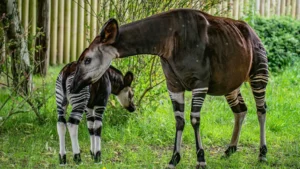
Can a Giraffe Breed with an Okapi?
Giraffes and okapis are both members of the Giraffidae family, making them relatives in the animal kingdom. Yet, when you
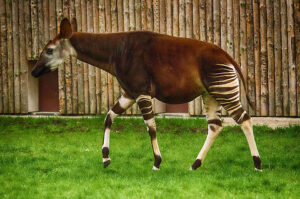
Is Okapi Half Zebra, Half Giraffe?
The okapi is one of the most fascinating creatures on Earth, with a mysterious appearance that often leads people to
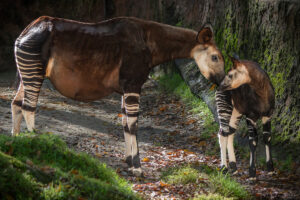
What Animal is Closest to an Okapi?
The Okapi, often referred to as the “forest giraffe,” is one of the most unique and elusive creatures in the
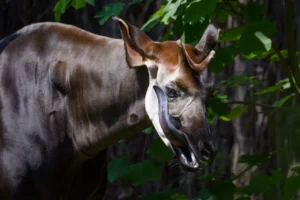
What Is Unique About the Okapi’s Tongue?
The okapi is a fascinating creature with several unique features, but one of the most remarkable things about it is
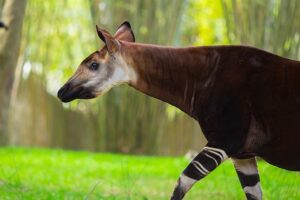
What Predators Hunt Okapis in the Wild?
Hidden deep in the rainforests of the Democratic Republic of the Congo lives an extraordinary animal with a fascinating appearance:
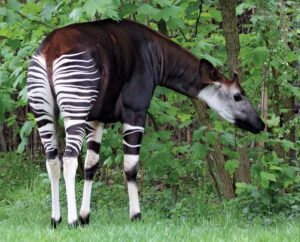
Why Do Okapis Have Four Stomachs?
The okapi, often called the “forest giraffe,” is a fascinating and unique creature found only in the dense rainforests of
